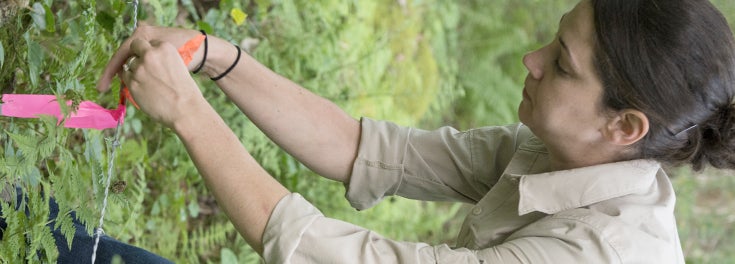
If your idea of a wild life is working closely with wildlife, then URI may be the place for you.
Research on local animal populations by URI biologists, as well as by state and federal biologists who collaborate with URI, provides our students with unique opportunities to get hands-on experience studying species from black bears and bobcats to ruffed grouse and the very rare New England cottontail.
Working with Professor Tom Husband and state biologist Charles Brown, for instance, students have begun monitoring 42 “bear detectors” around the state to assess the population of black bears in Rhode Island and determine their movement patterns.
“The project involves putting a rag dipped in fish oil up in a tree, then surrounding it with a knee-high ring of barbed wire to snag a bit of a curious bear’s fur for DNA analysis,” said senior marine biology major R.J. Turcotte. “We hope to determine whether there is a breeding population of black bears in the state.”
These opportunities have taught me so much about myself. Most importantly, I have learned that my outdoor hobbies and interests coincide nicely with my career path.
“We are hopeful that we can understand these animals and their patterns as they move into our increasingly urbanized environment and reduce the amount of human-wildlife conflict that arises,” said Professor Husband.
In a related project, more than 100 students have participated in a multi-year project to assess the population of the region’s only native rabbit, the New England cottontail. The species is on the verge of being added to the Endangered Species List after declining for many years, so students have visited dozens of sites seeking evidence of the rare bunny.
“These opportunities have taught me so much about myself,” said senior Kristin Bullett, a wildlife conservation biology major. “Most importantly, I have learned that my outdoor hobbies and interests coincide nicely with my career path. It was really exciting to discover that I can spend my life doing what I love while still making a living.”
URI students have also recently participated in field studies of wintering sea ducks along the southern Rhode Island coastline, the movement of spotted turtles across changing landscapes, diseases affecting starfish in Narragansett Bay, shark migration routes in the Atlantic, and several studies of migratory birds, among many others. Next spring, students will help with a new project to determine how many bobcats live in Rhode Island.
“I was really attracted to URI because of these types of opportunities,” Kristin said. “I didn’t want to just sit in a classroom and be lectured. I wanted to get out and be active in the field, which is exactly what these experiences have done for me.”
